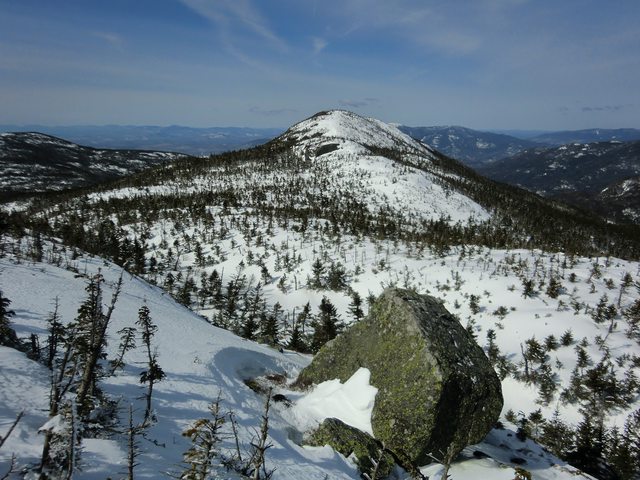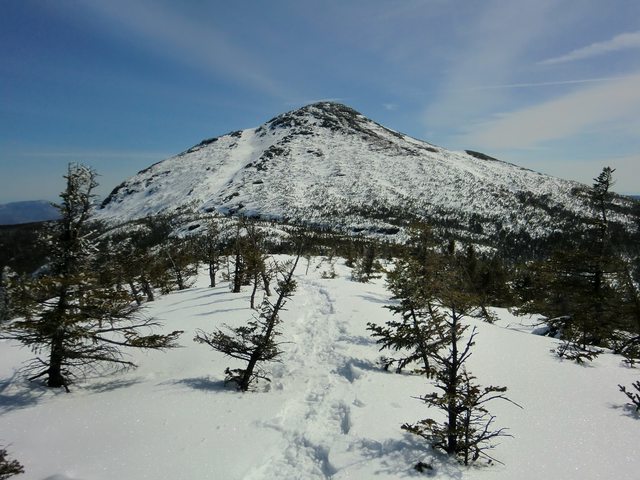I hiked Marcy to Gray in April 2011 on a deep, solid snowpack. Just a few treetops visible and no sprucetraps. It was a very enjoyable hike and far more interesting than the 'trade route' from Lake Tear.


However, outside of ideal snow conditions, the route is not only less appealing but the DEC has been discouraging hikers from using it for many years owing to destruction of alpine flora. Of course, the only way you knew that was if you stumbled onto it in a hiking forum or heard it from a ranger or summit steward. The posted sign now helps to publicize it. However, it might help to have a similar one posted at major trail-heads to
forewarn hikers. When several high-elevation lean-to's were removed in the mid 70's they posted signs at a low-elevation along the trail leading to the lean-to's (and not at the empty lean-to site). Best to know about the closure sooner than later.
If a "herd-path" is the human equivalent of a game trail (a distinct unofficial path forming after sufficient usage) then the term no longer accurately describes what one finds leading to the so-called "trail-less peaks". They may have started as "herd-paths" (decades ago) but, as part of a goal to minimize environmental damage caused by multiple braided paths to a summit, were winnowed to one or two paths to a given peak. These routes are, I feel, more aptly called "unmarked trails". They are officially recognized in Unit Management Plans (UMP) and receive light maintenance by trail adopters. A handful are indicated by DEC signs and even have bog-bridges to prevent destruction of alpine flora. That's atypical for a herd-path of bygone days. The latest ADK High Peaks trail map has even seen fit to indicate them. The term "trail-less peaks" is a throwback to yesteryear and fails to describe the modern reality; all 46er peaks have defined trails only some are not blazed. There are true herd-paths in the High Peaks: faint, unmarked, unmaintained, unofficial, and nowhere to be found on a map. None of the unmarked trails fit this description.
Carping about the condition of marked and unmarked Adirondack trails is a great pastime. I recall a hike to the Tripyramids in New Hampshire where during our ascent I pointed to the adjacent brook and chuckled "There's the Adirondack version of this trail!" However, I also accept these rugged, eroded, messy, and tortured paths to be part of the Adirondack experience. Frankly, they really don't seem much different (read: worse) since I first experienced them over 35 years ago. In some ways they are even better (protection and restoration of alpine flora) despite the tremendous increase in hiker traffic (and limited trail maintenance budgets). In lieu of quotas, I'd prefer to see more educational programs along the line of summit stewards (like trail-head stewards).
Having said all that, the initial section of trail to Cliff is truly memorable ... for all the wrong reasons!

A great motivator to hike in winter.


 http://www.adkmtnclub.blogspot.com/2015/07/gray-to-marcy-costly-bushwhack-is.html#more
http://www.adkmtnclub.blogspot.com/2015/07/gray-to-marcy-costly-bushwhack-is.html#more
















![Yellowstone National Park [Map Pack Bundle] (National Geographic Trails Illustrated Map)](https://m.media-amazon.com/images/I/51kGuJ72qjL._SL500_.jpg)














![Grand Teton Day Hikes and National Park Map [Map Pack Bundle] (National Geographic Trails Illustrated Map)](https://m.media-amazon.com/images/I/41DB0jvRnbL._SL500_.jpg)





















![Grand Canyon, North and South Rims [Grand Canyon National Park] (National Geographic Trails Illustrated Map)](https://m.media-amazon.com/images/I/419Y-ycyVUL._SL500_.jpg)









